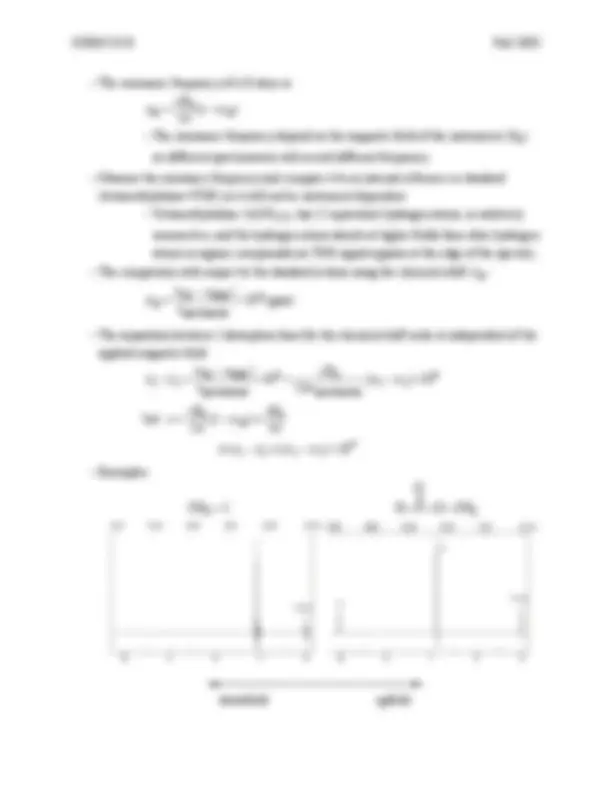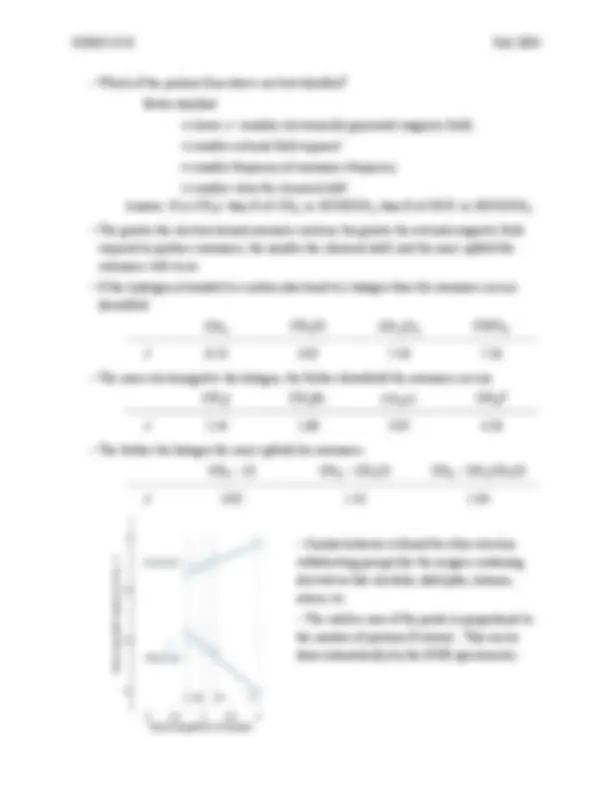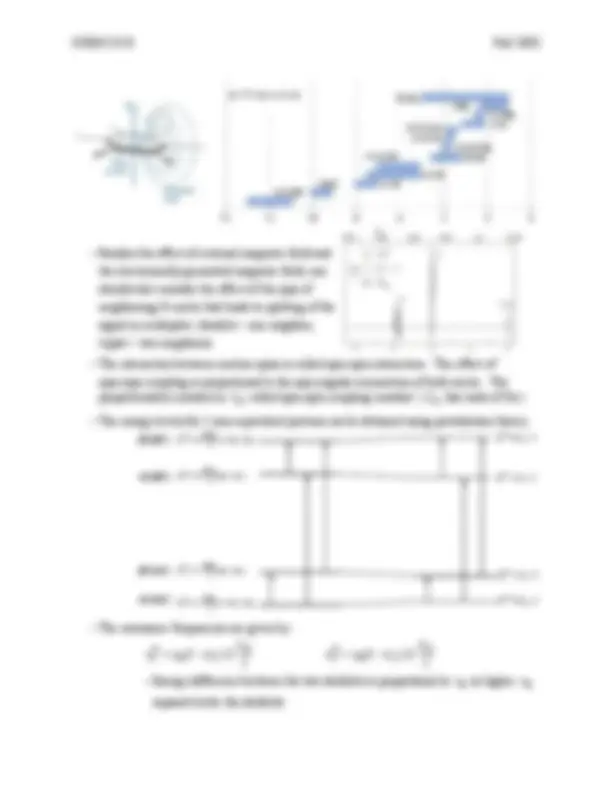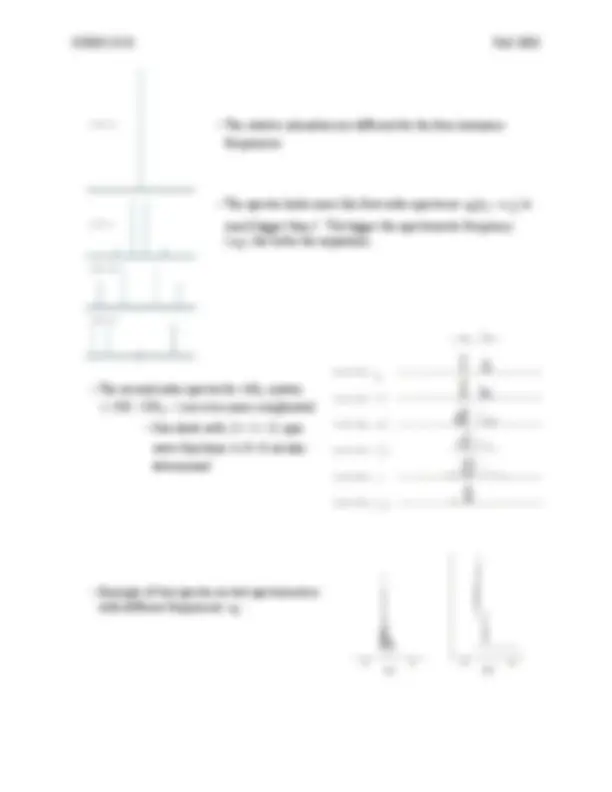Download NMR Spectroscopy: Proton Spin & Chemical Shifts in CHEM 3510, Fall 2003 and more Study notes Physical Chemistry in PDF only on Docsity!
Nuclear Magnetic Resonance (NMR) Spectroscopy
- We will focus our attention to the smallest nucleus, the proton.
- Similar to the electrons, the same nuclei have an intrinsic spin angular momentum ( I ). The nuclear spin eigenvalues equations for proton are analogous to the electron ones:
ˆ (^1) h
I = ^ +^2 β 1 2 β
ˆ (^1) h
I = ^ +
α h α
ˆ =^1
IZ β 2 h β
ˆ =−^1
IZ
- This intrinsic spin angular momentum confers the property of a magnetic dipole. The dipole moment is related to the spin angular momentum by:
μ = I = NβN I = γ I
N N (^2) m g g q
where g (^) N = nuclear g factor (a constant close to 1, characteristic to each nucleus) m N = mass of nucleus
β N = nuclear magneton
γ = magnetogyric ratio (characteristic to each nucleus, the higher it is the
easier to observe the nucleus in NMR)
- Placed in a magnetic field the nucleus (or electron) act like a small magnet.
- What happened with the energy levels in the presence of a magnetic field?
- The presence of magnetic field raises the degeneracy of the energy levels.
- The energy of the two levels that have m (^) I =± 1 / 2 (degenerate in the absence of magnetic field) changes as:
E =−h γ mI B z
where m (^) I =± 1 / 2 for proton B z = strength of magnetic field (units are Tesla (T) and gauss (G) where 1G = 10 -4T)
- Energy difference between mI =+ 1 / 2 level and m (^) I =− 1 / 2 level for the case of proton: ∆ E = E ( m I =− 1 / 2 ) − E ( m I=+ 1 / 2 ) =h γ B z ⇒ ∆ E depends on the strength of the magnetic field
- Example: the energy difference between the levels for a magnetic field of 21100 gauss (2.11 T) (the energy of the radiation required for a transition) is: ∆ E =( 1. 054 × 10 −^34 J⋅s⋅rad-1)( 26. 7522 × 107 rad⋅T-1⋅ s −^1 )( 2. 11 T ) ∆ E = 5. 95 × 10 −^26 J≈ 36 × 10 -6kJ/mol≈ 30 × 10 −^4 cm^ -
∆ E = h ν ⇒ ν = 90 MHz(radiofrequency region of electromagnetic
radiation)
- There is a direct correlation between the magnetic field strength and the frequency of radiation (called resonance frequency):
∆ E = h ν ⇔ (Hz)
z
ν = γ B ⇔ ( rad-1)
ω = γ B z
- Example: What magnetic field strength must be applied so a free proton will have a spin transition at 60 MHz? ⇒ (^) z =^2 = 14100 G
B^ πν
- NMR spectrometers can operate at fixed radiofrequency (resonance frequency) and variable magnetic field or at fixed magnetic field and variable frequency of radiation. The spectra is not dependant on which setup is used.
- Early NMR spectrometers worked with magnetic fields of approximately 14000 T that sets the frequency of proton transitions of about 60 MHz. These days the NMR instruments can work at 750 or even 900 MHz. High-frequency instruments are preferred because they give greater resolution.
- Not all protons resonate at the same frequency. The external magnetic field is shielded by other magnetic fields generating by surrounding electrons. The actual magnetic field acting on the nucleus is smaller than that of the external magnetic field. - The electronically generated magnetic field is proportional to the applied magnetic field:
B elec
B elec =− σ B 0
- The sign is negative because the electronically magnetic field opposes applied magnetic field.
- The proportionality constant σ is called shielding constant ( ) and it depends on the electronic or chemical environment around the nucleus.
≈ 10 −^5
⇒ B z = B 0 − σ B 0 =( 1 − σ) B 0 ⇒
B =
- Which of the protons from above are best shielded?
Better shielded ⇒ lower σ (smaller electronically generated magnetic field) ⇒ smaller external field required ⇒ smaller frequency of resonance frequency ⇒ smaller value for chemical shift. Answer: H in CH 3 I than H of CH 3 in HCOOCH 3 than H of HCO inHCOOCH 3
- The greater the electron density around a nucleus, the greater the external magnetic field required to produce resonance, the smaller the chemical shift, and the more upfield the resonance will occur.
- If the hydrogen is bonded to a carbon also bond to a halogen then the resonance occurs downfield. CH 4 CH^3 Cl CH 2 Cl 2 CHCl 3 δ (^) 0.23 3.05 5.33 7.
- The more electronegative the halogen, the further downfield the resonance occurs.
CH 3 I CH 3 Br CH 3 Cl CH 3 F
δ 2.16 2.68 3.05 4.
- The further the halogen the more upfield the resonance.
CH 3 − Cl CH 3 − CH 2 Cl CH 3 −CH 2 CH 2 Cl δ (^) 3.05 1.42 1.
- Similar behavior is found for other electron withdrawing groups like the oxygen containing derivatives like alcohols, aldehydes, ketones, esters, etc.
- The relative area of the peaks is proportional to the number of protons (H atoms). This can be done automatically by the NMR spectrometer.
- Besides the effect of external magnetic field and the electronically generated magnetic field, one should also consider the effect of the spin of neighboring H nuclei that leads to splitting of the signal in multiplets. (doublet – one neighbor, triplet – two neighbors)
- The interaction between nuclear spins is called spin-spin interaction. The effect of spin-spin coupling is proportional to the spin angular momentum of both nuclei. The proportionality constant is J 12 called spin-spin coupling constant. ( J 12 has units of Hz.)
- The energy levels for 2 non-equivalent protons can be obtained using perturbation theory.
α(1) α(2) (^) E 1 ( 0 )+ hJ 12 / 4
E 2 (^0 )− hJ 12 / 4
E 3 (^0 )− hJ 12 / 4
E 4 (^0 )+ hJ 12 / 4
E 1 (^0 )= −hγ 2 B 0 ( 2 −σ 1 − σ 2 )
β(1) α(2)
α(1) β(2)
β(1) β(2)
E ( 2^0 )= −hγ 2 B 0 (σ 1 − σ 2 )
E 3 (^0 )= +hγ 2 B 0 (σ 1 − σ 2 )
E 1 (^0 )= +h^ γ 2 B 0 ( 2 −σ 1 − σ 2 )
α(1) α(2) (^) E 1 ( 0 )+ hJ 12 / 4
E 2 (^0 )− hJ 12 / 4
E 3 (^0 )− hJ 12 / 4
E 4 (^0 )+ hJ 12 / 4
E 1 (^0 )= −hγ 2 B 0 ( 2 −σ 1 − σ 2 )
β(1) α(2)
α(1) β(2)
β(1) β(2)
E ( 2^0 )= −hγ 2 B 0 (σ 1 − σ 2 )
E 3 (^0 )= +hγ 2 B 0 (σ 1 − σ 2 )
E 1 (^0 )= +h^ γ 2 B 0 ( 2 −σ 1 − σ 2 )
- The resonance frequencies are given by:
2
1 0 (^1 1 )^12
J
ν ±=ν −σ ± 2
2 0 (^1 2 )^12
J
ν±=ν −σ ±
- Energy difference between the two doublets is proportional to ν 0 so higher ν 0 separate better the doublets.
- The spectra that are obtained when J (^) 12 ≈ν 0 σ 1 − σ 2 are more complicated and are called second-order spectra. - The ( n + 1) rule does not apply. The problem is solved using variational method.
- The case of 2 non-equivalent protons:
- The Hamiltonian: ˆ^ = − 0 ( 1 − 1 )ˆz1− 0 ( 1 − 2 )ˆz2+ 212 I ˆ 1 ⋅ I ˆ 2 h
H γ B σ I γ B σ I^ hJ
- There are 4 spin wave functions for the unperturbed system: φ 1 = α( 1 ) α( 2 ),
- Use a linear combination: ⇒ ψ = c 1 φ 1 + c 2 φ 2 + c 3 φ 3 + c 4 φ 4
- Minimize energy: = 0 ∂
c i
E (^) ⇒ obtain a secular determinant
1 2
1 2
1 2
1 2
d d hJ E
hJ d d hJ E
d d hJ E hJ
d d hJ E
where ( 1 ) 1 2 0
d = hv − σ 1 and 2 ( 1 )
d 2 = hv 0 − σ 2
E 1 h 0 1 1 2 +^ hJ
=− ν ^ −σ +σ ; [ 2 2 ]^1 /^2
2 4 2 02 ( 1 2 ) J
E =− hJ − h ν σ −σ +
[ ]
2 21 /^2 3 4 2 02 ( 1 2 ) J
E =− hJ + h ν σ −σ + ;
E (^) 4 h 0 ( (^1 12) +^ hJ
=^ ν −σ +σ.
- The allowed transitions are: 1 →2, 1→3, 2→4, 3→4 for non-equivalents H 1 →3, 3→4 for equivalent H
- There are 3 cases:
AB J
A
AX J
0 1 2
2 0 1 2
0 1 2
:
- The relative intensities are different for the four resonance frequencies.
- The spectra looks more like first order spectra as v 0 σ 1 − σ 2 is much bigger than J. The bigger the spectrometer frequency
( ν 0 ), the better the separation.
- The second-order spectra for system are even more complicated.
AB 2
( − CH −CH 2 −)
- One deals with ( 2 × 2 × 2 ) 8 8
spin wave functions ⇒ × secular determinant
- Example of two spectra on two spectrometers
with different frequencies ν 0 :
















